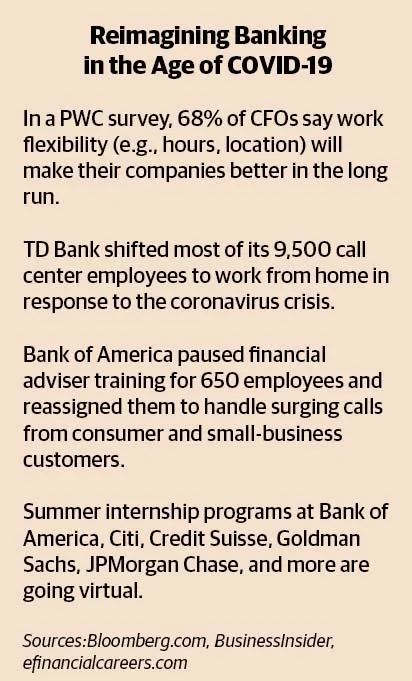When economic uncertainty strikes, customers naturally turn to their banks and other financial institutions for help. Fast, effective support is essential. However, the COVID-19 crisis is pushing firms’ resources beyond their limits. Financial institutions are facing a deluge of customer inquiries and inbound call volume as unemployment claims soar and individuals and business clients seek payment relief. Banks and lending firms are also dealing with the same operational disruptions and worker shortages as other businesses in the midst of a pandemic and economic fallout.
Financial leaders are working to keep communication channels open, manage revenue and customer expectations, while also thinking about market forces and business continuity strategies that will define their company’s future and their ability to rebound. Frankly, it’s a lot. The good news is that are numerous ways for banks and other financial institutions to minimize impacts to the customer experience and strengthen customer loyalty.
Here are 5 actions financial firms can take today to respond faster to customer support needs and position themselves to come out of the crisis even stronger.
1. Give customers fewer reasons to call
Heightened consumer and business lending needs have triggered a massive spike in loan applications and contact center volume. Customers are calling their financial institutions with plenty of questions – from looking for Paycheck Protection Program information, forbearance requests, or searching for guidance on how to take a short-term 401(k) loan. Service demand far exceeds capacity. At the same time, access to many lending institutions has been hindered. Managing the increased support volume while adjusting to new application processes and a distributed workforce has led to monumental challenges for the industry.
The most effective way to quickly reduce and manage contact center volume starts with proactively reducing the need for customers to call to speak to a human. Add a notification to online loan applications that automatically informs applicants what the next steps are along with a timeframe. Help customers help themselves. Let customers know that that the FAQ section has been updated with new information on loan criteria.
2. Triage calls to the right person (or bot)
Implement automation technology that identifies and routes calls and messages as they come in. For tier one questions (Do I qualify for this loan? How do I cancel a payment?) an AI-powered IVR system or chatbot can collect basic verifying information and in some cases, provide fast answers. For the calls or messages that are transferred to an agent, he or she already has the information needed to assist the customer, reducing average time in queue and allowing the agent to focus on the interaction. Leveraging the strengths and weaknesses of each channel provides the right support to the right customer.

3. Adopt a nimble cybersecurity mindset
Data security is paramount for financial institutions and their customers. Concerns about keeping client and transactional data secure were why financial services companies have long resisted allowing associates to work outside of a brick-and-mortar contact center.
When the coronavirus struck, that resistance quickly gave way to larger issues. It became a matter of associates working at home or not at all. Suddenly, banks and lending firms such as American Express, Capital One, and Synchrony were forced to shift most call center workers to work-at-home environments, Bloomberg reported.
For many financial firms, it was a significant shift in managing risk. As Senior Vice President Greg Smith, who oversees TD Bank’s contact centers in North America, told Bloomberg, "We can't control everything that you can control in the office, so we had to become comfortable with the way we mitigate our risk,"
To enable employees to work from home while maintaining stringent security measures, look or a partner with domain expertise in cybersecurity and technology. Does the partner offer up-to-date security tools and best practices to ensure rigorous data security and confidentiality? Those security measures should include two-factor authentication, hardware security devices, and giving the client control access to agents’ workstations, among other security practices.
4. Expand the talent pool
Banks are providing assistance to individuals and business clients affected by the pandemic by waiving fees; modifying loans; deferring credit, loan, and mortgage payments as well as making other adjustments. Customer concerns and requests are changing quickly and may require associates with different skill levels and licenses.
Even more the pandemic, licensed agents who can handle billing issues, modification requests, and a variety of other needs, were in high demand. However, mobilizing skilled and licensed agents at contact center locations is nearly impossible these days. Remote workforces offer a larger pool of available agents that can be scaled up or down as needed while reducing overhead costs. Look for an outsourcing partner that can provide a virtual workforce that is already regulatory and security compliant.
5. Fight fraud with technology and empathy
The race to provide consumers with much-needed financial support has created a fertile ground for tax-related fraud and identify theft. Reports show an uptick in phishing schemes and scams. Financial institutions have an opportunity to stay ahead of the issue and increase customer trust by ensuring real-time digital transparency and communication.
Much of fraud prevention involves repetitive tasks such as flagging suspicious accounts and activities and collating information. Fraud identification filters, algorithms, and knowledge management databases power fraud detection bots that can quickly alert companies to millions of attacks and suspicious activities. Technology can thereby relieve agents from performing many repetitive tasks and allow them to focus on more high-value ones, such as providing empathetic support and informing customers of next steps.
Indeed, the pandemic has accelerated expectations for digital-focused experiences. More than ever, customers demand seamless connections between brick-and-mortar branches and digital apps and sites. To that end, the COVID-19 pandemic presents an opportunity for companies to reimagine the employee and customer experience at a time when agility and innovation are necessary to not only survive but thrive.















